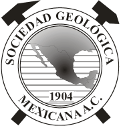|
BOLETÍN DE LA SOCIEDAD GEOLÓGICA MEXICANA, V. 53, n. 1, (2000) 59-71 http://dx.doi.org/10.18268/BSGM2000v53n1a3 |
|
Evolución tectonomagmática post-paleocénica de la Sierra Madre Occidental y de la porción meridional de la provincia tectónica de Cuencas y Sierras, México
José Jorge Aranda-Gómez1 *Christopher D. Henry2** James F. Luhr3***
1UNICIT, Instituto de Geología, UNAM, Apartado postal 1-742, Querétaro, Qro. 76001 México.
2Nevada Bureau of Mines and Geology. University of Nevada, Reno. Reno, Nevada 89557-008, USA
3Department of Mineral Sciences, Smithsonian Institution, Washington, D.C. 20560.
* This email address is being protected from spambots. You need JavaScript enabled to view it.
** This email address is being protected from spambots. You need JavaScript enabled to view it.
*** This email address is being protected from spambots. You need JavaScript enabled to view it.
Abstract
Since the Eocene, the most important geologic events in the region were volcanism and faulting. Magmatism related to subduction generated the voluminous Sierra Madre Occidental (SMO). Coincident with the waning of subduction, intraplate-type magmatism began in the region east of the SMO, and a combination of alkaline and tholeiitic magmatism began in the Gulf of California region.
Normal faulting produced the southern extension of the Basin and Range tectonic province. Upon part of this province was superimposed the oblique extension that generated the Gulf Extensional Province.
In many places, volcanism and faulting were simultaneous, or the faulting began a short time after the initiation of volcanic activity. Available information suggests that both phenomena occurred throughout the region during at least four distinct pulses: 32-27 Ma, 24-20 Ma, 12-10 Ma, and <5 Ma. However, the character and intensity of these pulses varied in a systematic way from one site to another. For example, the front of the voluminous felsic-intermediate, subduction-related volcanism and intense normal faulting shifted from NE to SW and was replaced by intraplate-type alkalic volcanism and extension of lesser magnitude.
The dominant felsic magmas associated with the Sierra Madre Occidental (SMO) could have been generated by partial melting of the crust, or by crystal fractionation of mantle-derived melts and simultaneous assimilation of crustal materials. The isotopic ages of zircons in crustal xenoliths from Chihuahua record an Eocene to middle-Oligocene thermal pulse that appears to be related to SMO activity. These xenoliths also provide evidence for high-grade metamorphic conditions in the middle and lower crust since the Miocene, which may reflect heating associated with extension-related intraplate magmatism.
The observed pulses of tectonomagmatic activity correspond to periods of increased divergence rate between the Farallon and Pacific plates, and/or with times of major plate reorganization. These events along the Pacific Coast had a manifestation within the continental interior. For example, there was an increase of the divergence rate during the period -30-24 Ma that caused volcanism and extension in the SMO. Likewise, coincident with the opening of the Protogulf of California (-12 Ma), extension and intraplate-type volcanism occurred east of the SMo. About the same time the orientation of the SMO volcanic front changed from NWSE to -E-W, and the composition of the erupted magmas changed from dominantly felsic to intermediate, marking the start of activity in the Trans Mexican Volcanic Belt (TMVB). The orientation of the TMVB has remained constant since the middle Miocene (-12 Ma), but the volcanic front has shifted toward the south.


